Snake Oiler
To me, Snake Oil has one meaning … and one meaning only. Mr. Snake Oiler is the number one most popular of all the antagonists to my beloved Speed Racer.

Snake Oiler from the original cartoon series Speed Racer.
For those of you who are not male and/or did not grow up in America during the 1970’s, or are not a child of someone who did, you probably think that snake oil refers to a fake medical therapy.
Here is an interesting side note:
(When the movie entitled “Speed Racer” hit theaters, my twin eight year old sons and I had tickets in our hot little hands on the first day it was released. Of course, I was proudly wearing my thirty year old faded T-shirt that sported a picture of the protagonist himself. I figured there would be kids at the theater who would think I was pretty cool. To my chagrin, there were three other individuals at this particular showing who were wearing the exact same shirt as me. All three were, like me, in their early forties.)
For all the rest of you who are not the least bit amused at my Speed Racer story, snake oil is actually an ancient Chinese remedy for joint pain. Many years ago the Chinese obtained oil from a water snake by the name of Erabu. They found that if it was applied to an arthritic knee there would be less pain and greater mobility.

Erabu- a Chinese water snake
When Chinese workers came to California in the eighteen-eighties to work on the Transcontinental Railroad, they brought with them some bottled Erabu oil. This oil came in handy for relieving the inflamed muscles and joints frequently caused by construction work. The American foremen, who typically did not speak Chinese, adopted the name “snake oil.” News of this treatment spread throughout the country and it soon became well known that “snake oil” was an effective treatment.
It turns out that Erabu oil is the richest known source of Eicosapentaenoic acid (EPA) in nature. EPA is an Omega-3 fatty acid from which the body makes prostaglandins that control some aspects of inflammation. It can be absorbed through the skin and it is an effective remedy for arthritic pain.
Of course, in our culture, “snake oil” is the pejorative way to refer to Placebo Medicine. Snake oil is the prototypical fake treatment. When I hear the term “snake oil,” I am reminded of the charlatans in the old west who would go from town to town selling petroleum jelly to use as a salve. They would call this treatment “snake oil” and would claim that it cured everything from measles to typhoid. They traveled in a covered wagon and would be in the next town by the time anyone figured out that they were fakes.
Despite having no physiologic effect, their snake oil actually did have a therapeutic effect. I imagine that a lot of the people they sold snake oil to would have welcomed them back if they ever chose to return.
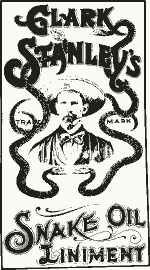
The snake oils of the old west may have been inspired by the Erabu but they rarely contained any of its oil. Even if they did, the real snake oil would have only been good for relief of mild arthritic pain. Erabu oil would not have cured the myriad of medical syndromes that the charlatans of the old west claimed it would. At least, it would not have cured those things through any real physiologic effect.
Actually, because it has a greater concentration of Omega-3 fatty acids than does salmon, it probably makes sense to consume it orally. We are now learning that things like high cholesterol and heart disease are made better by a diet that is high in Omega-3 fatty acids. Don’t be fooled, however, by anyone offering you West Texas Rattlesnake Oil.
I believe that the concept of “snake oil” accurately symbolizes the majority of therapies currently offered by practitioners of Placebo Medicine. Although some treatments have no physiological action what-so-ever and have a crazy rationale for use, most Placebo Medicine treatments do have some plausible rationale and a lot of them actually work for a specific purpose. Some of them even have side effects. You know, sort of like a real medicine.
Topically applied (Erabu) snake oil actually works for mild arthritic pain and, in this case, it is not a placebo. However, it does not work to reduce the size of a tumor and, in this case, it is a placebo. Rattlesnake oil does not even relieve joint pain and is a pure placebo.
Chelation therapy is an example of a currently marketed remedy that is similar to snake oil. It was developed in WWI to remove toxic heavy metals from the circulatory system. Heavy metals such as mercury, iron, arsenic, lead, uranium, plutonium and others are sometimes found in poisonous gases that are used during warfare. These metals can occasionally cause poisonings for other reasons as well. When used as a treatment for heavy metal poisoning, chelation therapy is not a placebo.
However, the most common use of chelation therapy today is to prevent coronary artery disease. The idea is that your body is contaminated with micro amounts of some particular heavy metal or other and you need to have your entire system “cleansed” from this impurity. In this case, chelation therapy is a placebo.
There are currently about a million other therapies that are just like snake oil and chelation therapy. For whatever reason, when a charlatan pretends to be in the healing field and pretends to be selling a healing product humans tend to suspend their disbelief and are gullible to sales pitches that make no logical sense.
As an aside, one of my favorite movies is The Outlaw Josey Wales starring Clint Eastwood as a Confederate soldier who refuses to surrender at the end of the Civil War. He has nothing to live for since the Union destroyed his farm and killed his family. While riding a ferry he is approached by a typical snake oil salesman. I love the way he handles this guy.
Video clip (0:43) The Outlaw Josey Wales snake oil salesman scene
Snake oil salesmen come is several flavors. Some snake oil salesmen are only interested in making a profit. We’ll call these people, “True Charlatans.” They are not interested in your health at all. They use the placebo effect, which will be explained in detail in the next chapter, to their advantage to sell product. They are simply trying to make money for themselves.
Other snake oil salesmen are interested in making a profit but they also believe some wild and crazy rationale. We’ll call these folks, “True Believers.” Some of them truly believe, for example, that the gods bestowed wisdom on some Chinese guy two thousand years ago and told him that if you stick needles in certain “meridian” locations on your body then you can align your “chi” and cure all ailments.
Interestingly, it is the True Believers that are the most dangerous. They are the ones who are most likely to make recommendations that are not in your best interest.
A True Charlatan just wants your money. He probably does not want to see you die from cancer. A True Charlatan wants you to stay alive so you can come back and buy more product. He also does not want his operation to be shut down. He will likely refer you to a regular physician if he suspects that you have a real tumor.
A True Believer, on the other hand, will continue in vain to “cleanse” your system until you ultimately succumb to the cancer.
No, nobody would do that … would they?
I will show you a few instances but, unfortunately, it happens so often that it isn’t even newsworthy.
Some of you probably believe that the government would not allow charlatans to sell fake remedies. Others of you probably think that these truly effective therapies are labeled as fake by the government as a part of a vast conspiracy to prevent you from having access to them. Some of you even think that the pharmaceutical industry actively discourages the use of effective treatments that are inexpensive so they can sell more expensive treatments to you.
Whatever your beliefs, I am sure that you will find the history of snake oil in America to be of interest. Come with me on a brief journey to explore this history?
•
In the nineteenth century you could get a U.S. patent for any kind of medicinal or cosmetic product. You didn’t even have to reveal its contents. In addition, there were no laws that required any kind of truth in advertising.
For example, Fletcher Sutherland and his seven daughters made their fortune selling hair tonic. With the unparalleled sales of their “secret” hair growing compound, the Sutherland family members were soon making more money than they could manage, yet spending far beyond their means on attendants, maids, valets, clothing, pets, gold, diamonds, houses, travel, drink and even the male callers who dared love the wild sisters.
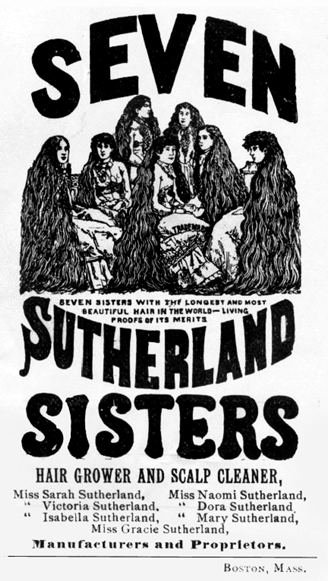
Patent Medicines became quite popular and were initially perceived as effective remedies. Keeping the ingredients secret seemed logical. After all, if you created a cure for rheumatism you should be able to protect it from others who might want to steal the secret formula. You should also be able to market it and distribute it as you see fit. Right?
Unfortunately, this opened the door for a generation of charlatans. You could put mud in a bottle and get a patent and call it “Medical Mud” and claim that it cures everything. The only thing that could limit your annual sales would be your skills and ability as a salesman.
After a half century of medical mud, guys like Upton Sinclair and Teddy Roosevelt influenced the U.S. Congress to pass legislation that would limit the fraud. The United States Pure Food and Drug Act of 1906 passed easily and everyone thought that the days of the medicine man were over.
Quacks everywhere suffered an initial setback but they re-tooled and came back stronger than ever. In response, the United States Federal Food, Drug and Cosmetic Act of 1938 became law. This time everyone really thought that the charlatans were done.
Unfortunately, the new law failed to clearly define the difference between a prescription drug and an over-the-counter drug. In (1951) an amendment gave the Food and Drug Administration (FDA) the power to classify a new drug as needing a prescription from a physician.
Unfortunately still, these laws failed to require that drugs be effective in order to be approved, only that they are safe. In (1962), another amendment gave the FDA the power to require that any new drug meet its standard for safety and effectiveness.
These advances coincided with an explosion of new pharmaceutical agents in the marketplace that we call the chemotherapeutic revolution. A number of additional laws and amendments have now been passed and these changes in the law were frequently in direct response to highly publicized medical tragedies.
Interestingly, public backlash at charlatan-induced wrongful deaths and new laws passed by congress have not slowed down the Placebo Medicine movement at all. In fact, the last sixty years has seen Placebo Medicine spawn into a trillion dollar a year industry.
The chemotherapeutic revolution has been an engine to this rapid growth. Every time a new and legitimate drug comes out hundreds of placebo imitations suddenly spring to life.
I hope that you appreciate how I used the word “spawn.” Pretty cool word choice, huh? I like it. Sounds frightening … like science fiction or something.
All that “spawn” stuff would be slightly amusing except that this stuff is real. It is science fact, not fiction, that Placebo Medicine is a trillion dollar per year industry. A trillion dollars!;
Think about it. For a trillion dollars we could have kicked butt in Iraq, Afghanistan, North Korea, and Iran. Or, better yet, for a trillion dollars we could have elected John Kerry. Hey, don’t be pissed at me for leaning to the left on this issue. The one and only time that I actually remembered to cast a vote it was for George Bush Sr. Actually, I just cast my second ever vote and it was for Obama. Hey, I wanted to vote against Clinton back in (1992) but I forgot, so go figure.
OK, Placebo Medicine is a big industry. What is so bad about that? I mean, some treatments are expensive or invasive or entail undue risk but most are inexpensive and pretty safe. As long as no one is getting hurt, who cares if some people get ripped off?
The problem is that people are getting hurt.
Generally speaking, the United States Government only acts when there is a crisis. There has to be some really big outcry or something in the headlines or some disaster or dogs and cats living together or something really big like that. Our government has passed laws to protect its citizens from medical fraud twenty four times since (1906). In each case, there was an instigating event or set of events. Here is a list of these laws and the date that each one came into effect.
The Pure Food and Drug Act (1906)
The Sherley Amendment (1912)
The Food, Drug, and Cosmetic Act (1938)
The Public Health Service Act (1944)
The Durham-Humphrey Amendment (1951)
The Food Additives Amendment (1958)
The Color Additives Amendment (1960)
The Federal Hazardous Substances Labeling Act (1960)
The Kefauver-Harris Drug Amendments (1962)
The Drug Abuse Control Amendments (1965)
The Fair Packaging and Labeling Act (1966)
The Radiation Control for Health and Safety Act (1968)
The Poison Prevention Act (1970)
The Medical Device Amendments (1976)
The Proxmire Amendment (1976)
The Infant Formula Act (1980)
The Orphan Drug Act (1983)
The Drug Price Competition and Patent Term Restoration Act (1984)
The Prescription Drug Marketing Act (1988)
The Safe Medical Devices Act (1990)
The Nutrition Labeling and Education Act (1990)
The Dietary Supplement Health and Education Act * (1994)
The Food Quality Protection Act (1996)
The FDA modernization Act (1997)
* There is a disclaimer in regards to dietary supplements. An effort in the early nineties to better regulate dietary supplements was derailed by the health food industry. The result was that the definition of a dietary supplement was not only enlarged but these items actually gained their own independent regulatory classification. Therefore, dietary supplements are not regulated in the same way as regular medications. For example, there is no requirement to demonstrate safety and effectiveness prior to marketing a health food product such as Miracle Cure! The FDA’s ability to regulate dietary supplements is woefully inadequate and likely won’t change until a tragedy occurs.
health food industry. The result was that the definition of a dietary supplement was not only enlarged but these items actually gained their own independent regulatory classification. Therefore, dietary supplements are not regulated in the same way as regular medications. For example, there is no requirement to demonstrate safety and effectiveness prior to marketing a health food product such as Miracle Cure! The FDA’s ability to regulate dietary supplements is woefully inadequate and likely won’t change until a tragedy occurs.
Now, let’s look at why some of these laws were passed.
Here are seven instances of individuals who pretended to be altruistic healers but actually committed some of the most egregious health care fraud this nation has ever seen. Each case is an example of a charlatan promoting his or her own brand of snake oil. For a larger list of snake oil salesmen you can visit this website:
Quackwatch– Promoters of questionable methods
(1) Albert Abrams (1863-1924) was an American self-proclaimed doctor, well known during his life for inventing machines which he claimed could diagnose and cure almost any disease.
Abrams promoted an idea that electrons were the basic element of all life. He called this ERA, for Electronic Reactions of Abrams, and introduced a number of different machines which he claimed were based on these principles.
The Dynomizer looked something like a radio. Abrams claimed it could diagnose any known disease from a single drop of blood or, alternatively, from the subject’s handwriting.
The Dynomizer was big business and by (1918) courses in “Spondylotherapy” cost two-hundred dollars. You could rent your very own Dynomizer for about two-hundred dollars down and five dollars per month thereafter. The lessee had to sign a contract stating the device would never be opened.
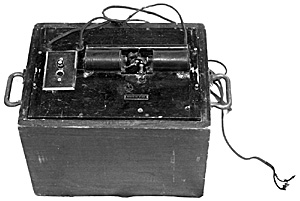
Then, he came up with new and even more impressive gadgets such as the “Oscilloclast” and the “Radioclast.” These gadgets came with tables of frequencies that they were to be set to in order to “attack” specific diseases. Clients were told cures required repeated treatments. By (1921), there were claimed to be thirty five hundred practitioners using ERA technology. You can learn more about this and other fake medical devices at:
Bob McCoy’s Museum of Questionable Medical Devices- Video Vault
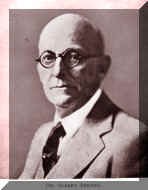
In (1923), an elderly man who was diagnosed in the Mayo Clinic with inoperable stomach cancer went to an ERA practitioner who treated him and declared him “completely cured.” The man died a month later and a public uproar followed.
An AMA member sent a blood sample to an Abrams practitioner and got back a diagnosis that the patient had malaria, diabetes, cancer and syphilis. The blood sample was from a rooster. Similar samples were sent to other Abrams practitioners. A few found themselves facing fraud charges in court. In a case in Jonesboro, Arkansas, Abrams was called to be a witness but he died of pneumonia before he could attend court.
With Abrams gone, the AMA publicly opened up one of his machines. Its internals consisted of nothing more than wires connected to lights and buzzers.
(2) John Romulus Brinkley (1885-1942) was a controversial American medical doctor who experimented with xenotransplantation of goat testicular glands into humans as a means of curing male impotence.
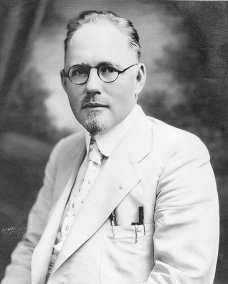
In (1918), Brinkley began to perform operations which he claimed would restore male virility and fertility by implanting the testicular glands of goats in his male patients at a cost of seven hundred and fifty dollars per operation. He hired a press agent, advertised in newspapers, and used direct mail to promote his procedure. During his medical career, more than sixteen thousand people were victims of needless insertion of goat testicles.
Unfortunately, Dr. Brinkley was not a very good physician. He frequently operated while intoxicated and in a less than sterile environment. As a result, some patients suffered from infection. Also, an undetermined number died.
In (1930) his medical license was revoked by the Kansas State Medical Board after forty three deaths were attributed to his “cures”.
(3) W. J. A. Bailey (1884-1949) mixed the radioactive element radium with water and called it Radithor. He proclaimed that it was “A Cure for the Living Dead.” 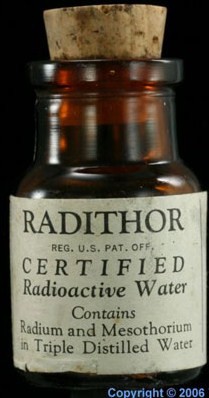 This meant that it was a cure for mental illness and retardation. One of Radithor’s biggest fans was Eben Beyers, a steel tycoon in Pittsburgh. Over a number of years, Mr. Beyers drank fourteen-hundred bottles of Radithor. He became so seriously ill with radium poisoning that portions of his mouth and jaw were surgically removed before he died in (1931). His death, noted on the front page of the New York Times, marked the beginning of the end of the popular radium water cures and led to new laws as a part of the Federal Food, Drug, and Cosmetic Act of 1938.
This meant that it was a cure for mental illness and retardation. One of Radithor’s biggest fans was Eben Beyers, a steel tycoon in Pittsburgh. Over a number of years, Mr. Beyers drank fourteen-hundred bottles of Radithor. He became so seriously ill with radium poisoning that portions of his mouth and jaw were surgically removed before he died in (1931). His death, noted on the front page of the New York Times, marked the beginning of the end of the popular radium water cures and led to new laws as a part of the Federal Food, Drug, and Cosmetic Act of 1938.
(4) Dr. Ernst T. Krebs, Jr. (1912-1996) who is not a physician, developed and promoted the idea that laevo-mandelonitrile-beta-glucuronoside also called amygdalin, laetrile, or vitamin B-17 is an effective treatment for cancer. Despite scientific studies that demonstrated it was ineffective and too toxic for use in humans, Krebs pursued the marketing of laetrile as an anti-cancer treatment. With the help of others he was able to successfully promote his treatment. Clinics were established and doctors were trained and patients were treated.
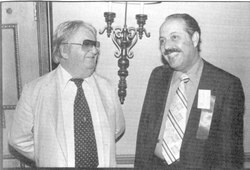
Here are a few case histories:
Chad Green was a twenty-one year old man from Massachusetts who developed acute lymphocytic leukemia. Although he was rapidly brought into remission with chemotherapy, his parents started him on “metabolic therapy” administered by a Manner Metabolic Physician.
Harold W. Manner, Ph.D. was actually the chairman of the biology department at Loyola University in Chicago. He claimed to have “cured cancer” with injections of Laetrile, whose active ingredient is cyanide, and proteolytic enzymes and massive oral doses of vitamin A. He reported his experiments in a chiropractic journal and wrote a book called The Death of Cancer. He founded the Metabolic Research Foundation and began training physicians for a fee. After Loyola asked him to step down, he founded a clinic in Tijuana, Mexico, that offered “metabolic therapy.” In (1982), a reporter from WBBM-TV Chicago became Metabolic Physician #(219) by attending a seminar in Los Angeles and donating two hundred dollars to the Metabolic Research Foundation. To indicate his “professional” background the reporter used the initials “D.N.,” which, he later explained, stood for “Doctor of Nothing.” Manner promised to refer ten patients a year to him.
When Chad developed signs of cyanide toxicity, Massachusetts authorities had him declared a ward of the court for treatment purposes only. His parents then brought suit to re-institute “metabolic therapy.” When the court ruled against them, they fled with Chad to Mexico, where he was treated by Dr. Ernesto Contreras. Several months later Chad died in a manner suggestive of cyanide poisoning. Dr. Contreras stated that the boy had died of leukemia, but was a good example of the effectiveness of Laetrile because he had died a pleasant death!
Chad’s parents stated that he had become very depressed because he missed his grandparents, his friends and his dog.
Joseph Hofbauer was a nine-year-old boy with Hodgkin’s disease which, like acute lymphocytic leukemia, has a ninety-five percent five year survival rate when treated appropriately. Joseph’s parents never allowed him to receive appropriate treatment but insisted that he receive Laetrile and “metabolic therapy.” When New York State authorities attempted to place him in protective custody, his parents filed suit and convinced family court judge Loren Brown to rule against recognized treatment of Hodgkin’s disease. Brown stated that,
“This court also finds that metabolic therapy has a place in our society, and hopefully, its proponents are on the first rung of a ladder that will rid us of all forms of cancer.”
Joseph died of his disease two years later and Judge Brown says today that he continues to be haunted by the memory of this case.
If you want to learn more about the benefits of the wonder drug laetrile check out this informative site: Laetrile
In case you think that the laetrile story is historical and could not happen today, I direct you to the modern day laetrile advocate G. Edward Griffin’s website: Vitamin B-17
(5) Almon Glenn Braswell (1943-2006) was the king of mail order dietary supplements. He probably sold more herbs, vitamins, antioxidants, minerals, and amino acids through the mail than any other individual in history. Unfortunately for him, he was also the king of health-related false representation complaints filed by the United States Postal Service. One-hundred thirty-eight false representation complaints were filed against fifty different medical/cosmetic products marketed by Braswell, Inc. He plead guilty to mail fraud charges involving the faking of before and after advertising photographs purportedly revealing the results of bust developer, hair growth and cosmetic products, and was sentenced to five years probation.
products marketed by Braswell, Inc. He plead guilty to mail fraud charges involving the faking of before and after advertising photographs purportedly revealing the results of bust developer, hair growth and cosmetic products, and was sentenced to five years probation.
He was also sentenced to a three-year prison term for Federal income tax evasion and perjury charges developed during the mail fraud investigation.
Despite the fact that he was not a reformed criminal and went right back to doing the same stuff when released, President Clinton gave him a full pardon for this offense in January of (2001) on his last day in office. Apparently, Hillary’s brother was given two-hundred thousand dollars for the favor.
Ironically, the backlash intensified an ongoing investigation and ultimately resulted in another conviction in (2004). This time he served eighteen months and got hit with a ten and one-half million fine for income tax evasion.
Most of Braswell’s marketing was done under the name GERO VITA International, which offers a large line of “dietary supplements” from its Web site and by mail. Although he died in (2006) his company lives on. In fact, you can click on his website and order a cure for any ailment you could possibly think of.
![]()
Here is an example of an add you might have seen in a magazine or other publication. This is a classic Braswell solicitation:
 I think that the “cleaning old deposits out of your chimney” image is particularly creative.
I think that the “cleaning old deposits out of your chimney” image is particularly creative.
In case you think that charlatans are only of historical note, I want to show you two modern day individuals who are continuing this long and rich tradition. They are a bit unique in that each has real credentials. They were both trained at medical schools and both became doctors. The first one is a True Charlatan in that he is very smart and very devious. The second is a True Believer in that she is convinced that the cure she discovered is real.
(6) Dr. Stanislaw R. Burzynski (1943-) obtained his medical degree in Lubin, Poland, in (1967) and a D.Msc. degree in (1968). He never completed residency and he never got a PhD. He immigrated to Houston, Texas, in (1970) and obtained a license to practice medicine in (1973). In (1976), he announced that he had developed a brand new cure for cancer. He had no cancer research experience and quickly found that his ideas were not going to be accepted. He defends himself against the academic medical establishment, the FDA, and various medical insurance providers on the grounds that,
“Copernicus, Galileo, and Pasteur were persecuted by ignorant contemporaries when they challenged the traditional assumptions of their day.”
Little Sophie is a twelve year old girl who survived a cancer scare at age two. She is very happy to be one of Dr. Burzynski’s miraculous cures.

Unfortunately, Dr. Burzynski has treated thousands of patients over a thirty year period with medicines such as Aminocare A-10 Cell Protector but has failed to do a single legitimate double blind placebo controlled trail and has received no support from anyone in the real scientific community. Those who have tested his antineoplastin theory in clinical trials have had negative results.
Little Christina was a ten year old girl who was not as fortunate as little Sophie. On July thirteenth, (1998), it was reported in the Los Angeles Times that,
“Dr. Stanislaw Burzynski of Houston has been sued for fraud by the family of a patient who died. Mark and Susan Bedient of Lockport, New York, are seeking unspecified damages in connection with the death of their daughter, Christina, who died of brain cancer at age ten. The Bedients sought Burzynski’s treatment in December (1995). The treatment ended in May (1996), and Christina died a month later.”
If you visit his elaborate web site or go to his large clinic in Houston you will find that his evidience for effectiveness is largely based on poignant testimonials from ardent supporters who treat him as a folk hero.
Before the Texas Attorney General won a ruling stating that Dr. Burzynski could no longer treat patients with his proprietary antineoplastin regimens, the good doctor grossed forty million from (1988) to (1994). Following the ruling, he lost the ability to treat patients outside of an FDA approved study protocol, he could no longer advertise that neoplastins cure cancer, he was restricted from distributing his product and he was forced to reimburse the state of Texas to the tune of fifty thousand dollars for court costs. True to form, he claims that,
“If I am put out of business by the State or Federal authorities, my patients will be the ones sentenced to suffer and die– not me.”
(7) Lorraine Day, MD , (1937-) claims that she had breast cancer and cured herself with diet and natural therapies. She tells people to stay away from doctors and not to take any drugs. She says that the drugs will actually cause cancer. She goes on to say that, “The entire foundation of conventional medicine is based on ERROR.”
She says, “I cured myself and I can tell you how to do it. All you have to do is pay nineteen dollars and ninety-nine cents for my DVD or video and thirty-five dollars for the accompanying workbook. I will show you my incredible ten-step plan and you will be totally cured of any cancer that you might have.”
Dr. Day’s grandiose personality notwithstanding, there is another way to cast doubt on her claims. On her website she provides a photo of her breast and says, “This is the huge tumor that grew in three weeks.”
I seem to recall that when I went to medical school breast cancers tended to be black and brown and irregular and ugly and take five or ten years to grow. Benign cysts, on the other hand, tended to be plump and red and symmetrical and they tended to grow more rapidly.
What do you think she had?


Dr. Day’s breast
Why don’t we move a little further north in regards to Dr. Day’s anatomy and try to make her real diagnosis. After all, I am a psychiatrist.
You have probably heard that it is politically incorrect for a psychiatrist to make a psychiatric diagnosis without adequately evaluating an individual. You have probably also figured out that I am enthusiastically not politically correct. I also think that in the majority of cases it’s pretty easy to make a psychiatric diagnosis.
I believe that Dr. Day has bipolar disorder with megalomania and likely a significant amount of paranoia. Individuals with this condition tend to speak in exaggerated terms. She likely suffered an extended depression and then spoke about it as though it was a near death experience. A depression is usually an episodic condition but it can last up to six months or a year or more. Resolution is gradual and likely coincides with her experience as she used diet and supplements to get better.
It would be like rubbing a rosary to cure a cold. You might take ibuprofen and an antihistamine and a decongestant and a cough medicine and these drugs might make you feel pretty groggy. After several days of still being sick you decide to stop taking drugs and start rubbing your rosary. By day four or five or six you are less groggy and starting to feel better. Finally, the cold goes totally away. You feel very proud of yourself because you discovered a new cure that conventional medicine has overlooked. Rubbing a rosary cures the common cold!
Since Dr. Day seems to suffer from a real psychiatric illness we must have compassion for her. However, she is exploiting a vulnerable group of newly diagnosed cancer patients for personal gain. Therefore, we must support efforts to reduce her ability to do this. So far, the FDA has only sent her warnings in regards to the way she is advertising her supplements.
It is likely she has caused suffering and death but it is very difficult to document poor patient outcomes and attribute them directly to her. Due to the fact that she is a True Believer, she will likely slip up at some point and get caught but I hope it is not due to a needless tragedy.
I hope that I have adequately demonstrated that the medical marketplace can be a dangerous and deceptive location. After one-hundred and fifty years of professional charlatanism in the United States and after one-hundred and three years of laws to protect us from it, there seems to be no let up in sight. In fact, it seems to be getting worse and worse.
Placebo Medicine is funny, confusing, scary, insane, and very, very interesting. I keep asking myself, “Why is it so easy to get smart people to believe such illogical things?”
One purpose of this book is to entertain you with the history of snake oil. Another is to mystify you with the placebo effect. A third purpose is to warn you about which “alternative” therapies to avoid. After these goals have been met, you might be asking yourself, “Do you think that Dr. Levy has any real ideas about what we should do or does he just want to make jokes?”
I do have a plan. I suggest a course of action that we can take to navigate these treacherous waters. I offer this plan as but one idea. I am not an activist and I am not trying to promote any change in the medical establishment. I just had this idea and wanted to share it for the sake of discussion.
Obviously, if we continue to let the promoters of CAM therapies run wild, then a lot of people will continue to get hurt. On the other hand, patients frequently present with psychosomatic complaints. That is, complaints of physical symptoms for which there is no underlying physiological explanation. Also, a lot of patients are very suggestible and a placebo can actually affect the course of certain conditions in this group. Therefore, there is a place for Placebo Medicine in the armamentarium of conventional treatments.
So, what would be the best strategy going forward?
I suggest that the American Medical Association establish guidelines for a few treatments and a few types of practitioners that are “approved.” Then, every medical school has a short course to teach what is approved and how to make referrals.
OK, all you docs, nurses, medical researchers, and general skeptics out there who just became so disgusted with my antics that you don’t even want to finish reading this chapter, please chill out for a second. I ask that you reserve your judgment for two more paragraphs. At least, wait until we get to the deceiving patients stuff.
The idea is that people are sent for Placebo therapy when they have a lot of psychosomatic symptoms and/or when they rate high on a suggestibility scale. The MD or DO continues to follow-up and be responsible for the patient and the Placebo treatment augments what he or she is doing.
Insurance companies can establish a small amount of compensation for “complimentary” therapies. The therapy would need to be one of the AMA approved treatments and the reimbursement would be the same for all therapies in this category.
Let’s say that your family doctor refers you for Placebo Medicine Therapy or PMT (I apologize for suggesting that we introduce yet another set of silly letters into our vocabulary.), then your insurance company will provide fifty dollars per month or something like that. You go to an herbal specialist and benefit from the placebo effect yet continue to be followed by your family physician. Patients with psychosomatic complaints tend to cost the insurance companies a lot of money and I am sure they would not mind paying fifty dollars per month to lessen this burden.
But we can’t authorize physicians to lie to their patients, can we?
I believe that deception is not a requirement for the placebo effect to work. No medical research has ever demonstrated that it is.
As an analogy, hypnosis is widely believed to be a therapeutic modality that uses deception on a highly suggestible patient. In fact, hypnosis works best when a highly suggestible patient is fully knowledgeable about the procedure and wants to do it. A patient who has the ability and the desire and who trains properly can even undergo a surgical procedure as complex as open heart surgery with no exogenous analgesia.
I think that you can say to your patient, “I’m sending you to a Placebo Medicine specialist who will administer magnetic therapy. The magnets are inert but they create a way to think about getting better that can be therapeutic. If you carefully follow the direction of the magno-therapist your brain will produce endorphins that will relieve the pain in your elbow.”
If placebo treatment is done in this way, it will still work. Remember, you are selecting a patient who is high on the suggestibility scale and you are employing the full doctor-patient relationship. It is my belief that these are the essential elements.
The explanation that you give the patient does not have to be some mumbo jumbo about ancient Chinese guys. You can simply explain our current knowledge about the neurobiology of the placebo effect. You can show data that demonstrate the effectiveness of placebo. You can present colorful brain images that show real placebo effects.
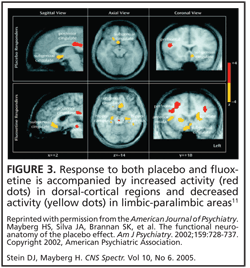
You can administer suggestibility and psychosomatic instruments and explain to the patient how they are fortunate to have a high likelihood of responding to placebo. You are not being deceptive when you say, “Considering your scores on these scales you have a high probability of responding well to PMT.”
I think that when doctors lost the ability to prescribe a sugar pill back in the fifties they lost a lot. Since a huge number of patients respond to placebo it would be nice if doctors were able to use it. We also need to steer the CAM movement away from those who would be less than ethical practitioners and place it in the hands of people who are more likely to be altruistic.
Drs. Burzynski and Day notwithstanding, most of us who had to get two diplomas, pass our boards, obtain several licenses, take an oath, and be accountable to half a dozen regulatory boards in order to practice legitimate medicine tend to be a bit more altruistic. At least, when you have done all that you tend to be a bit less likely to take a short cut and rip patients off.
What would be the result if the AMA were to take over the CAM movement?
I would guess that the truly altruistic folks would work within the official guidelines and the charlatans would lose their ability to paint conventional medicine as the enemy. Also, family doctors would get to use placebos again. It would be a win-win situation for all of medicine.
Call me silly.
Register to receive notification of new content.
